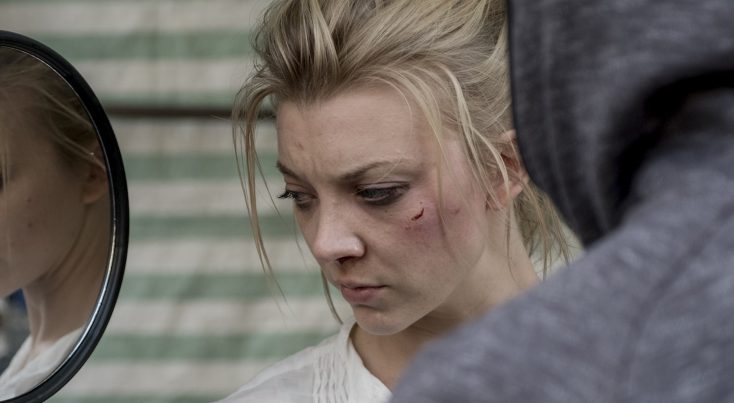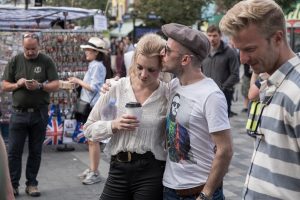By PETERSON GONZAGA
Front Row Features
HOLLYWOOD—It was during an editing project that writer/director Anthony Byrne was inspired to create his newest film, “In Darkness.” The native Dubliner was in London working in post on a previous film in a seemingly abandoned building. He thought he was alone in the building but realized he wasn’t. A woman lived above the editing suite where he was feverishly cutting a film, day and night. The sounds of the woman walking back in forth in her heels got his brain churning to start writing a script about it. Having writer’s block after getting a portion of the script down, he asked his fiancee, Natalie Dormer (“The Tudors,” “Game of Thrones”), to take a crack at it. Their collaboration led to the film, which is now in theaters and on video-on-demand (VOD).
Dormer plays Sofia, a blind musician, who hears a scuffle in the apartment above her. The commotion turns out to be her neighbor (Emily Ratajkowski), who has been murdered. Discovering that the deceased is the daughter of a Serbian businessman accused of war crimes makes Sofia a target for murder, possibly a mysterious character named Marc (Ed Skrein, “Game of Thrones”).
In a chilly room at a swanky Beverly Hills hotel, Byrne puts on his sweater to warm up as he extolls his journey of creating “In Darkness.”
Q: How did you and Natalie come together and decide to create this film?
Byrne: I was in London to cut a film to post and I realized after a couple of months, I hadn’t seen anyone else in this building—not in the lobby nor in the lift (elevator) nor in the corridors— and it felt kind of weird. It took a long time to realize there wasn’t anyone else in the building. Then, late one night this woman would come home and click-clack around in her apartment (above) and never took off her heels. It was the same sound all the time. For me, the first thing is to kick off my shoes, especially if I was wearing high heels for whatever reason. (He laughs.) But I never saw her. I started to imagine who she was and what she was doing and what else was doing and you build that experience from there.
The germ of the idea was that I was blind and I was trying to figure out what her life is like and what’s going on. Nat was in a particular place in her career where she was getting scripts playing the same roles. She was feeling very frustrated by people wanting her to be one thing. At a certain point, I had broken the story where I couldn’t get any further with it. I said to Nat, “Will you write this with me and write the female role that you want to see.”
We were trying to come up with a great female protagonist which, now that it’s coming out, feeds into the conversation that’s happening in the industry about strong roles for women.
That became the journey of writing it and we were done with it for quite a number of years. We had a lot of fun talking about the story; trying to break the beast of the story. We hung it up on the wall of our apartment in London, and we had a timeline. We had it broken down while we were writing it.
Q: In the film, there are little surprises here and there, twists and turns and whatnot. Was that something you and Natalie had to weave through and make sure it connects back to the original storyline?
Byrne: That’s why we had it all written up on the wall so you could step back from it and look at it visually. It’s so hard to flick through pages and step back and go, “Act one. Act two. Act three.” Follow the timelines and where is the character and what’s she doing. What does the audience know? What do we know and keep a track of that? That’s quite tricky and then when you re-writing. You get notes and soon as you take one thing, the whole thing starts to fall apart. The re-writing is harder and it’s also the best thing because it forces you to making sure you’re keeping your feet to the fire.
Q: Were there times when you and Nat wanted to re-write something and thought it was a great idea but then realized it’s not going to work?
Byrne: There were always times like that. The father reveal came quite late in the overall writing. We were missing something in that strand. It’s was like, “What would make this already dark scene even more darker, messy and complicated.” They were fun conversations to have because we love the genre of psychological thrillers. I think everybody loves thrillers. It’s a genre that crosses every spectrum and everybody has an appetite for a thriller. That essentially what we love to do. We’re in the position to add another thriller in the canon of great thrillers. That’s what we were trying to do as writers.
Q: There’s one scene in the film, without revealing too much, where she’s supposedly by herself, but she isn’t. Was that something you had to think about in shooting the film and being aware of her sensory perception as a blind person?
Byrne: What we had established at the beginning was a visual grammar of her routine. Once we had done that and we understood that there was a rhythm and a tempo to the film, you can discern that. It obviously works both ways, but when she comes in, he’s there to kill her. She comes in, follows her routine. Walks over and does the thing with the speaker. He’s there standing still and the scene progresses. Those were scenes we loved discussing when we were in production on how we would do it. That informed the location of the apartment. It goes back to the visual grammar on how do you build suspense and how do you stay rigid to the rules of the film that we established. That’s how that played out.
Q: Since you also were the writers as well as the director, did that make it a little bit easier for you to set up those scenes?
Byrne: Yeah, it’s about the visuals. At a certain point it, happens with everything I do. It’s a strange process. I know the script so well and I spend so much time in prep. Prep is so important. When it comes down to the shoot, I have to almost have to forget the script. There were so many times I’d turn to the script supervisor and go, “What happens? Where was she before and where is she after this?” It’s not that you don’t know the script, but it’s just being here for the moment. The visceral immediacy of what you’re doing and you’re thinking visually. You’re also sort of policing the grammar of how you shoot this film because you can’t be here all the time and when you’re with her (Natalie) you have to be in back of her and follow her. In following her, it allows you to become a voyeur as well. If the camera was in front of her, you’re not thinking this way. When you’re a blind person in her apartment and you’re walking behind her, it plays visually and how you psychologically evaluate what you’re seeing and where she is. They were great conversations to have with Nat and to talk through and conversations with the director of photography.
Q: Did you and Nat work with a blind person to understand how they moved and acted in real life?
Byrne: Yeah. We were very lucky to have the Royal National Institute of the Blind in London help us. They gave us an awful lot of support. We went and spent time with them and we blind and partially blind people there they brought in so we could get to know them and ask them questions of what it is like because there’s a perceived visual grammar that has been presented to film and TV forever about what blind people do. Stumbling around with their arms flailing and also that they just live in the dark. None of it is true, but is the perceived imagery of film and TV, and we have to push that aside. Obviously, it helped in terms of lighting the apartment. Partially blind and sighted people, the vast amount of them turn on the lights in their apartment. That was a sense of safety and security in doing so. With Nat, she had lessons with the cane and there was this woman that Nat spent some time with her in closing her eyes while walking down the street or wearing eye masks and walking around even in your own apartment. It’s amazing when you do it.
Q: Did you do it yourself?
Byrne: I did have go. I had to understand what Nat’s going to be doing. It’s incredibly difficult and also for Nat when she’s doing scenes with Ed Skrein and like how we’re making eye contact now, she couldn’t do that. On camera, your connection is emotional (with the eyes). That’s the connection, especially when you’re editing and when you’re looking at each other. There’s a power in one shot to the other shot and how you’re going to manipulate and use it. But, if she’s looking here (angled), Ed has to find an emotional connection with somebody that’s not making eye contact. That was tricky as well.
Q: How was it working with Ed Skrein and him understanding that Nat is blind in this film?
Byrne: Ed is amazing. First of all, he’s the loveliest man. He was fully onboard. He’s a great collaborator, a great friend. He was great supporter of what we were doing. He bought into it straight away. We met him on a plane. There was nobody else in this section of the plane and I was like, “That’s Ed.” I had a picture of Ed from years ago. I didn’t know who he was and I was like, “Every time I think of Mark, I think of this guy.”
Nat saw that too. She said, “He’s that guy in ‘Game of Thrones.’” I said, “Who’s that guy. He looks like the guy in the picture.” It was Ed Skrein. We then met and it was Ed Skrein of “Game of Thrones.” It was Ed Skrein and Natalie Dormer at the beginning of this project and it ultimately became Natalie Dormer who helped get it made. Working with Ed became really easy because it was the three of us having conversations. It’s like this role-reversal where he’s playing a wounded and vulnerable damaged person who is in deep conflict. He’s playing what traditionally would be the female role in these kind of movies and Natalie is kind of the stronger protagonist role who is leading it. It was a challenge for him. “






